Last month, I introduced you to a hand embroidery thread that’s not quite on the market yet, but hopefully, will be available next year some time (fingers crossed!). It’s called silk gimp, by Access Commodities. You can read about it in this article on silk gimp, and you can also see the autumn tree I embroidered with it in this article.
When we were discussing the silk gimp, several folks chimed in with the information that Pipers Silks also makes silk gimp. I thought it would be fun to compare the two. I ordered some of the silk gimp made by Pipers so that we can look at both types up close and perhaps understand better the structure of different threads and their uses.
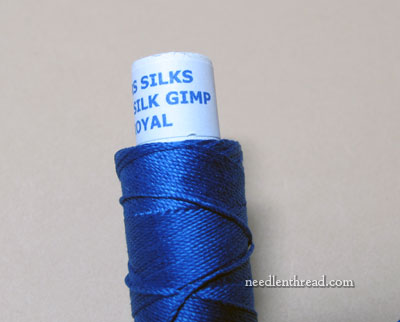
Pipers Silks Silk Gimp
Pipers silk gimp comes in several different weights, because it is essentially a lace-making thread.
In the photo above, you can see Pipers Silks gimp in a glorious royal blue, thread weight 30/3. This number implies a three-ply thread of 30 weight plies, so it’s a relatively heavy thread. (In thread, the lower the number, the heavier the thread. The second number indicates the number of plies.) It reminds me of a buttonhole silk, but it’s slightly stiffer than buttonhole silk.
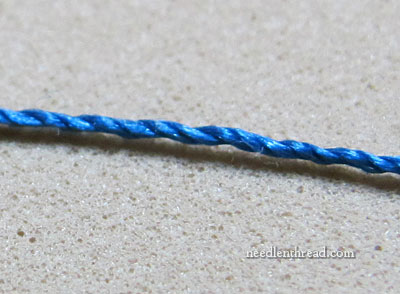
You can see the thread up close here. You can see that it is a twisted thread, with the typical rope-like structure of a twisted thread.
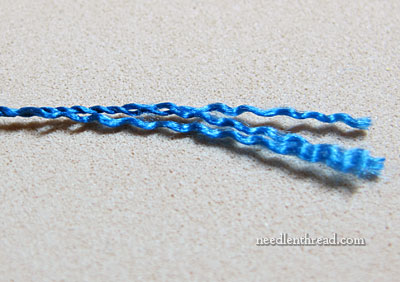
If you unravel the ends, the three plies come apart. It is a filament silk with a high sheen, but again, it is slightly “stiffer” than most twisted filament silks.
This type of gimp can be used for embroidery (more on that below), but it is meant for lace-making and tatting and the like.
Access Commodities Silk Gimp
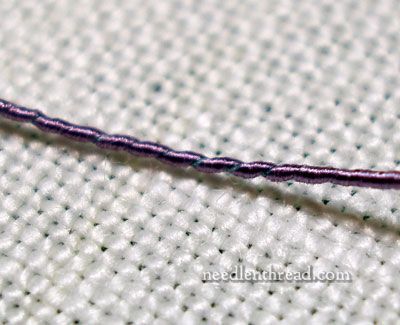
This is the silk gimp that I was playing with last month, by Access Commodities. You can see the difference in the structure – the outside is made of a very smooth wrap of flat filament silk, around a silk core, giving the gimp an incredibly smooth finish that does not resemble a regular twisted embroidery silk.
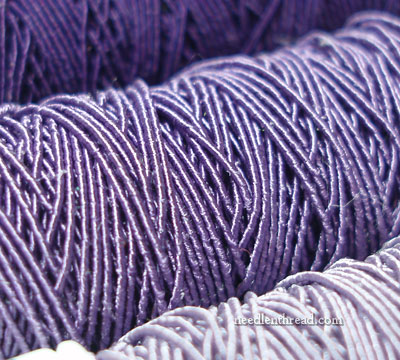
Again, the Access Commodities silk gimp. Notice that it is not made of plies of silk twisted together. There’s no rope-like look here.
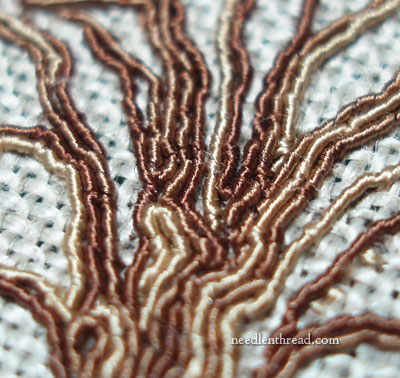
Here, the AC silk gimp is couched in lines to form tree branches. It is a very supple thread, very fluid, with no stiffness. It’s a very fine thread (it’s tiny – you can see a comparison picture in this article). It takes more careful handling and requires some getting used to – it’s not quite like other threads you’ll encounter in your stitching life, which makes it very difficult to describe.
Differences Between the Two Silk Gimps
1. There’s an obvious difference in structure. Pipers silk gimp is made from plies of silk twisted together. Access Commodities silk gimp is made from a core of filament silk, around which is wound flat silk, resulting in a smooth, almost tube-like surface around the core.
2. There’s a big difference in the way the two threads handle. The Pipers gimp handles like silk thread, and depending on the weight (it comes in various weights) some seems a bit stiffer than others. The Access Commodities silk gimp is fluid and supple, with no stiffness about it at all.
3. There’s a difference in the way they are used and what they’re made for. The Pipers gimp is made for lace-making, tatting, and the like. It can perhaps be used as a finishing “cord” for small things, too. And it isn’t unfeasible to use it for some surface embroidery applications. Because of its rope-like structure and slight stiffness, though, it would not “blend” the same way other silk threads would. Think of it more like a buttonhole silk that would work well for certain types of individual surface stitches – that would make good crazy quilt seam treatments and the like. But it’s definitely more of a tatting / lace-making (maybe even crochet) thread than an embroidery thread.
Access Commodities silk gimp is made specifically for hand embroidery, and, as its 17th century counterpart, would be used mostly in surface couching, detached stitches, and the like. It’s not a lace-making thread.
4. There’s a huge difference in the way they look. Most of the Pipers silk gimps look like ropes (see the exception below). Access Commodities silk gimp looks more like a smooth, tubular thread. This goes back to the whole structure point in #1, above.
More Pipers Silks Silk Gimp
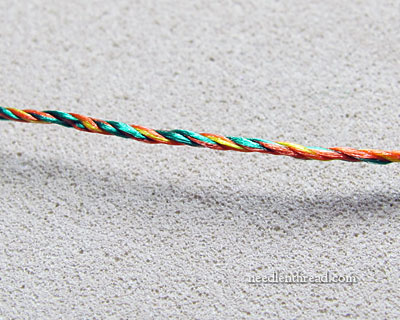
Here’s another example of the Pipers Silks silk gimp – one of their heather colors. It’s a very sunset-ish color scheme in filament silks, all rolled into one twisted silk thread, speckled with color.
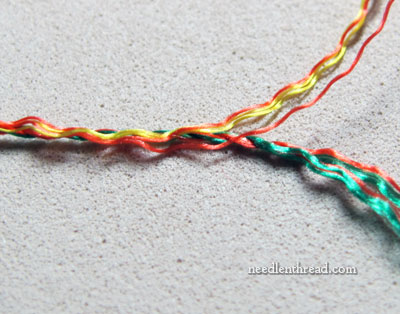
I like it! Can’t you see it on a Southwest-flavored crazy quilt seam, or something like that? I like the way the individual filaments separate in their whole colors, but when they’re together, they almost look like little splashes of paint along the thread.
Oh, silk! It’s such amazing stuff!
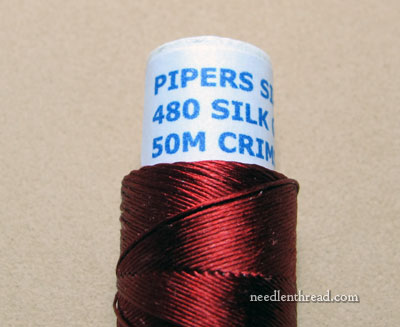
This is another type of silk gimp from Pipers – it’s their 480 gimp. It’s a thicker, stiffer, filament silk, with the filaments twisted together in long twists, which makes that surface finish look very smooth.
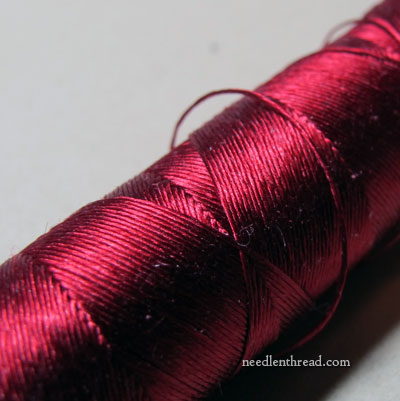
It has a beautiful sheen, and it’s surprisingly stiff. Not wiry, mind you – just stiffer than you’d expect a filament silk to be.
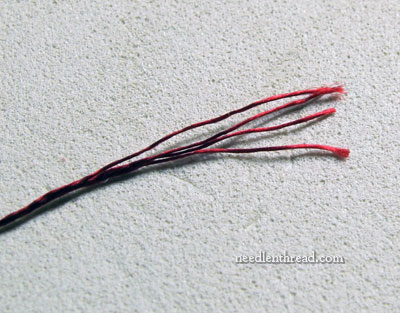
You can see that it’s made up of four plies, but they aren’t twisted in short, tight twists – so it doesn’t look as rope-like. You can often see this type of gimp outlining various design elements in different types of laces.
So those are the two types of silk gimps, just to show you the difference between them. I think both threads are really interesting, and I’ll be playing with them a little more. I’m eager to fiddle about with the Pipers gimp, to see how it would work in certain types of surface stitching. So I’ll show you that a bit down the road!
Questions? Comments? Ideas? Thoughts? Speculations? Have your say below!







If the photo isn’t reversed some how, the Pipers looks like a Z twist. Will that make any difference in how to use it since it’s a stiffer thread? I remember your blog on S vs. Z twists and how certain stitches look different depending on the twist.
One interesting thing I learned about spinning numbers (the 30/3, like the Pipers gimp) – in the older systems, each different fiber has a number based on the number of hanks of yarn of a given length (for silk, 840 yards) spun from a pound of fiber. So a #20 yarn makes twice as much yardage per pound as a #10.
Now, most of the spinning numbers are metric. You can be sure, if it has NM next to the number. In that case, regardless of fiber, the number refers to meters per gram – so a 30/3 NM weight silk is three plies, each 30 meters per gram. I haven’t had any occasion to do a side-by-side comparison with yarns from both systems, and it’s really tough to tell if somebody’s on the old system unless they say so.
HI Mary!
Fabulous article today. I enjoy embroidery and weaving with silk, so this article and the previous ones were of profound interest to me.
One request, Your photography is clear and sharp, but would you mind adding something like a thumb or quarter to your pictures for scale?
Please?
Thanks!
That’s a good idea, but please don’t use a coin.
I am not American and many of your followers (disciples?) aren’t either, and have no idea of the actual size of your coins. Your thumb or finger or even a little ruler would be good.
Hi Mary,
Oh – looks like fun and shine. Instead of investigating – I stayed away from silk because I never knew how to care for the item when completed – washability, sun, etc. Maybe
I overlooked it in your article – so I will ask you about these concerns. Thanks for sharing so much knowledge with us.
Dear Mary
Thanks for your article on the difference between the two silks and how to use them. Like you I bought the blue Pipers silk gimp thread and yes there are differences between the two. I was wondering what I should use the Pipers silk thread for so thanks for explaining how to use the thread. I can’t wait to see how you will use Pipers thread.
Regards Anita Simmance
Am I ever grateful to you that you – literally – take things apart for us and let us have the benefit of your rich experience! Your total involvement is so good to witness – it doesn’t make me feel too bad about my own relative uninvolvement. At least SOMEbody does it….
G’day Mary,
By the time I finished this post I had gimps boggling my mind. Kind of like… “Mary Corbet had a sewing box, ee-i- ee-i-oh. In that sewing box she had some silk, ee-i-ee-i oh. With a gimp, gimp here and a gimp gimp there, here a gimp, there a gimp, everywhere a gimp, gimp.” !! haha
I’ve often sung my granddaughter to sleep, when she was younger, with ‘Old MacDonald had a farm’. For a bit she’d sleepily suggests another animal and then she’d become quiet. She doesn’t drop off easily though so after a time I’d test her by singing “Old MacDonald had some chocolate…or green hair etc! I never thought of gimps.
Now, where was I? Oh, the gimps. Very, very interesting. I didn’t realise the ‘ins and outs’ of the stuff. I looked up gimp in the dictionary and one item was gimp fishing line – silk core wrapped with wire. I googled the fishing line but the explanation soon slid every which way, and, phew, it wasn’t wrong then when it stated that “it’s hard to imagine one word could have so many definitions”.
Thanks for all your info on the gimp that interests us most.
Cheers, Kath
Thanks Mary for your article. I googled gimp thread after your last article and found it at Pipers and the many weights and didn’t know which one would be similiar the the Access gimp.
Bring it on Access Commodities – I really want to try stitching with it. I love the richness of silk,this looks a gorgeous thread.
Thank you so much for this informative article. It is so useful.
I love these kinds of instruction you give to us, Mary. It’s bewildering to see the variety of materials available without understanding why and for what they were developed, but now I am much more enlightened. Thank you.
So, what does the word ‘gimp’ mean? The two threads seem like different threads in the way they are made.
I would use the Silk Gimp to enhance a design that includes tree trunks, leaves on the ground, and a small footpath running between the trees. I have the idea in m head, and I think this silk gimp, especially in these colors, will give some textural interest to this embroidery. I would use this gimp as surface, and would couch it down with Silk floss of varying colors.
Sure I would like to take it in my hands and try to create some beautiful embroidery. I am fascinated and very excited to see them
Hope to be lucky, I really want them. I wish to be the winner.
Thanks
Fernande
Could any and if so which of the silk gimps discussed be used to make a braided or rope-like link between the two front sides of an oversize suit coat? Ideally the link might have a three-quarter inch loop at either end to go around a button on each side of the garment.
I think you can actually purchase braid made for this type of purpose. There’s a line of trim called “Garniture” that has some fancy braids made in thread that has the look of silk gimp.
Mary,
I just REALLY LOVE your website sew VERY VERY MUCH! I have been reading your Blog for the last couple of years when I have time. I have learned so much from you. I learned the basics of embroidery from my Maternal Grandmother when I was 12 years old and I have been doing several other types of needlework for the last 46 years and I still love it all!
I have never heard of Silk Gimp and now I can not wait to try some! Thank you for all that you do for so many including me.
BTW, I love ❤️ Cosmo embroidery floss, it is my favorite.